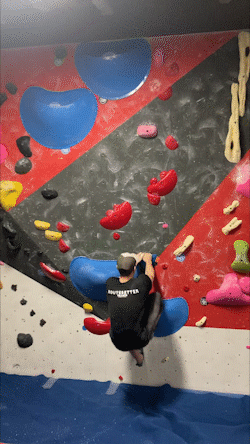Breakdown
Climbers: Eddie Pandolfino 6’0”/-2, Joey Costanzo 5’8”/+0, Hans Ma 6’1”/-1, Patrick Mrozek 6’0”/+4.5
Wall Angle: Flat
Holds: Thrive Fiberglass Volumes (discontinued), Kilter Sandstone XL 2 Jug
RIC: Risk 2-4, Intensity 2-4, Complexity 1
The intention for this boulder was to present climbers with a dyno that they could gradually increase difficulty on. Risk is present because of the “all points off” movement required to reach each finish hold. This necessitates climbers to properly judge their momentum and direction. Climbers experience intensity through the bicep and tricep strength needed to generate momentum off of the starting jug, with additional fast-twitch contact strength needed to control the target hold. Complexity is low because there is little sequence variation or alternate betas.
Influence/Aesthetic:
The concept for this climb is something that many members ask for to practice specific movement or coordination skills. I wanted to play with the idea of the dyno being slightly uncomfortable, with climbers starting in a scrunched position. This encourages a more explosive movement that gets climbers closer to the wall. Aesthetically, the start feet and finish holds are placed equidistant and in alternate directions to create a mirroring effect. Dead space in between these pairings creates contrast and visually reinforces the dyno theme.
Hold Selection:
Commonly these “stepping stone” dynos are usually set with bucket jugs as the target holds. The fiberglass holds complimented with screw-ons encourage a more accurate approach. The positive part of the hold is smaller, but the distance traveled is decreased. This can help to test the climber’s reactivity when attempting to control the hold. The feet are also quite large, which puts more of an emphasis on catching the target hold than intricate footwork to gain proper momentum.
Swinging (Slightly) Sideways
The climber begins by placing their right foot and immediately shifting their gaze to the target hold. Their hips are also shifted slightly rightward to open the body to leftward movement.
There is a slight swing downward to generate momentum for the upward pull as the climber’s left foot smears on the wall for an additional upward drive.
The hands quickly leave the start as the left foot comes up to the second foothold to direct the climber’s momentum slightly leftward.
The climber’s left-hand catches the target hold and the right comes up to stabilize. Their feet smear the wall to completely slow momentum.
One-Two Punch
Joey begins the boulder identically to the first example. However, his hips are slightly closer to his midline because he is aiming more upward and less to the right.
His left foot utilizes the right side of the second foothold to generate upward momentum and his hands leave the start hold slightly later so they can create more momentum at his apex.
Joey Utilizes the first target hold to pull through and guide his momentum to his right hand can reach the second target hold.
Live and Direct
Hans begins the boulder straight on (similar to Joey) and places his feet in nearly identical positions.
During this pull through it is important to note that Hans’ left leg extends completely straight off of the high left foot as his hands leave the start hold. This continues his momentum once his hands are off the wall.
He is easily able to control the finish with one hand as his body is still in midline because of his straight upward trajectory.
Going for Gold
Patrick begins most similar to Hans, as he is aiming slightly rightward of where the start holds are.
His launch setup is similar to previous examples. However, Patrick’s left knee is positioned leftward as it hits the second foothold.
This keeps his hips square to the wall for longer, which keeps him from falling too far away from the wall to catch the lip.
Final Thoughts
Skill training boulders can be a valuable way to teach climbers intimidating or nuanced movements. Trackable progress is one of the most important ways to denote growth. It is difficult for climbers to see improvement in dynos if their only encounters with them are contained within other boulder problems and not isolated. Presenting a situation where the dyno (or other movement) is the only obstacle to overcome makes failing more manageable and progress immediately visible. This repetitious practice creates familiarity and comfort with foreign movements.




